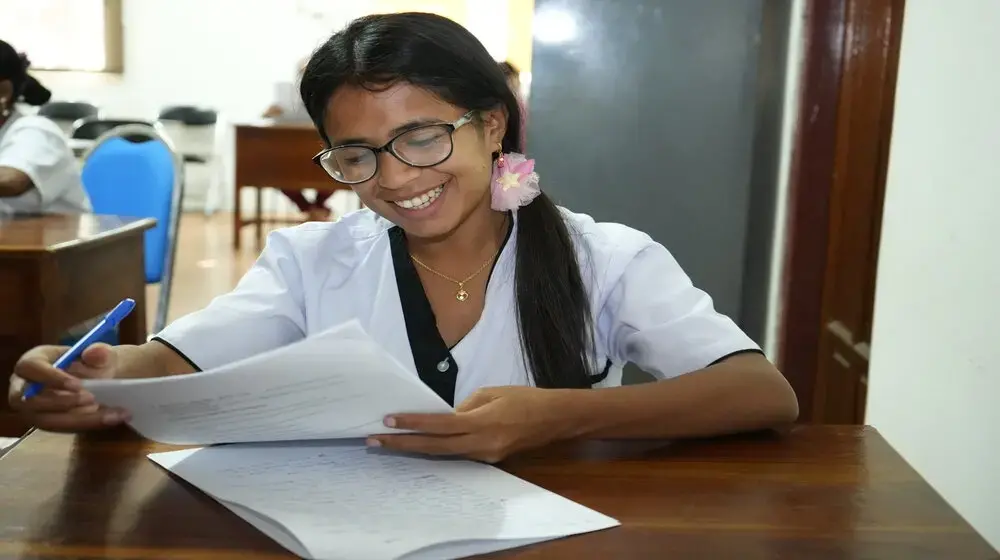Maliana, Timor-Leste- Stepping into the Uma Lulik (a Timorese traditional Conical Hut architecture), Dr. Domingas Sarmento saw a remembrance photo of a young lady. Sitting on the ground, the father and his kids have been long awaiting her and the group of midwives arrival. Dr. Sarmento from UNFPA focusing on Reproductive Health Project, is one of the doctors who organized the Maternal Death Verbal Autopsy orientation in Maliana.
Maternal death verbal autopsy is an approach used to obtain cause of death by interviewing family members on the signs and symptoms experienced by the mother before death. Focused and concentrated, Dr. Sarmento supervised how the midwives and doctors conducted verbal autopsy reporting through interviewing the family members on the recent death of the mother. “She has been told by the doctors not to deliver at home……She was supposed to go to the doctor before labour pain started, but what happened was only when she has labour pain, they tried to find transportation to reach the health facility…..but there was no transportation available”. Dr. Sarmento described the incident on this 32-year-old mother giving birth to her 6th child.
Highest estimated maternal mortality in South East Asia
This family is like many of the families in Timor-Leste where the mothers lose their lives during pregnancy. Timor-Leste is one of only nine countries worldwide estimated to have reduced its maternal mortality ratio by over 75% since 1990. Since 2003 UNFPA has been working with the Timor-Leste government to achieve and maintain this trend. However, despite the reduction of maternal mortality, Timor-Leste still records the highest estimated maternal mortality ratio in South East Asia. The country’s maternal mortality ratio maintained at 215 per 100,000 in 2015. The figure reflects insufficient care for mothers during pregnancy and delivery and poor access to health care.
“They [pregnant mothers] deliver at home, and then when there is complication, that is the time they will call for help. But it is already too late” said by Dr. Francis Saison, another doctor from the UNFPA Reproductive Health Project. Dr. Saison also mentioned that many Timorese women prefer home delivery after they experienced smooth delivery at home. “Every delivery is not the same. The more deliveries a woman has, the more complicated the next delivery will be… if they [pregnant mothers] ask for help earlier, they could be saved”.
Reviewing Maternal Death cases
Maliana is one of the sites of project on Verbal Autopsy, which is supervised under Maternal Death Surveillance Response System (MDSR). UNFPA and WHO have been taking the lead to provide technical support to the Ministry of Health (MoH) to count and review all maternal deaths in the country, aiming to take preventive and corrective actions to avoid preventable maternal deaths in the country. In 2014, MoH, with the technical assistance from UNFPA and WHO, launched a road map to implement MDSR system in the country and further a group of 4 officials from the MoH were supported to participate in a technical workshop on MDSR. The Maternal Death Review process was established in the National Hospital and five Referral hospitals in 2015. In 2016, verbal autopsy reporting was introduced. In 2017, the MDSR process has been expanding beyond the six hospitals.
“In some health posts, there are no doctors, only one midwife is providing the service….Although we talk about system and everything, but in reality, there are so many drawbacks. “said by Dr. Amita P. Thapa from WHO, who also conducted the MDSR training in Maliana. “This country needs to emphasise training and to have a monitoring (system) which includes everyone in the medical sector. “
“Information on the levels and causes of maternal mortality is critical in determining the public health importance of specific maternal health problems and in designing appropriate interventions to reduce maternal mortality. Accurate information on the nature and prevalence of causes of death is essential to guide policy-makers in setting priorities for Safe Motherhood programmes” said John M. Pile, UNFPA Country Representative. A monitoring system, like verbal autopsy, can play an important role in reviewing the maternal death cases and thus reducing maternal mortality ratio. The UNFPA will continue working hard to ensure every pregnancy and childbirth is safe in Timor-Leste.
-Chang Tsz Yu Patty




